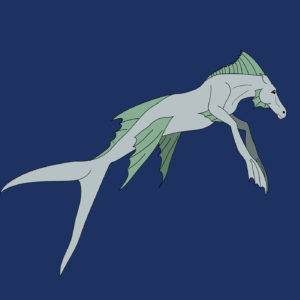Hippocampus (hi-poh-kahmp-uhs)
Hippocampus or Hippocamps was the name given to marine horses. Males were “stallions” and females were “mares.” Hippocamps under one year were “yearlings,” and were “colts” or “fillies” until they were four years old. The pectoral fins located on either side of the head were used for maneuvering.
The sea stallion was equipped with a pouch on the ventral, or front-facing, side of the tail. When mating, the mare deposited up to 1,500 eggs in the male’s pouch. The male carried the eggs for 9 to 45 days until the yearlings emerged fully developed, but very small. Once the young were released into the water, the male’s role was done and he offered no further care and often mated again within hours or days during the breeding season.
Before breeding, hippocamps courted for several days. The courtship behavior synchronized the animals’ movements and reproductive states so the stallion could receive the eggs when the mare was ready to deposit them. During this time, they changed color, swam side by side holding tails or gripped the same strand of sea grass with their tails, and wheel around in unison in what was known as a “predawn prance”. They eventually engaged in a “true courtship prance” lasting about 8 hours, during which the stallion pumped water through the egg pouch on his trunk which expanded and opened to display its emptiness.
When the mare’s eggs reached maturity, she and her mate let go of any anchors and drift upward snout-to-snout, out of the seagrass, often spiraling as they rose. They interacted for about 6 minutes, reminiscent of courtship. The mare then swam away until the next morning, and the stallion returned to sucking up food through his snout.

